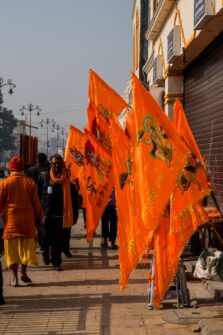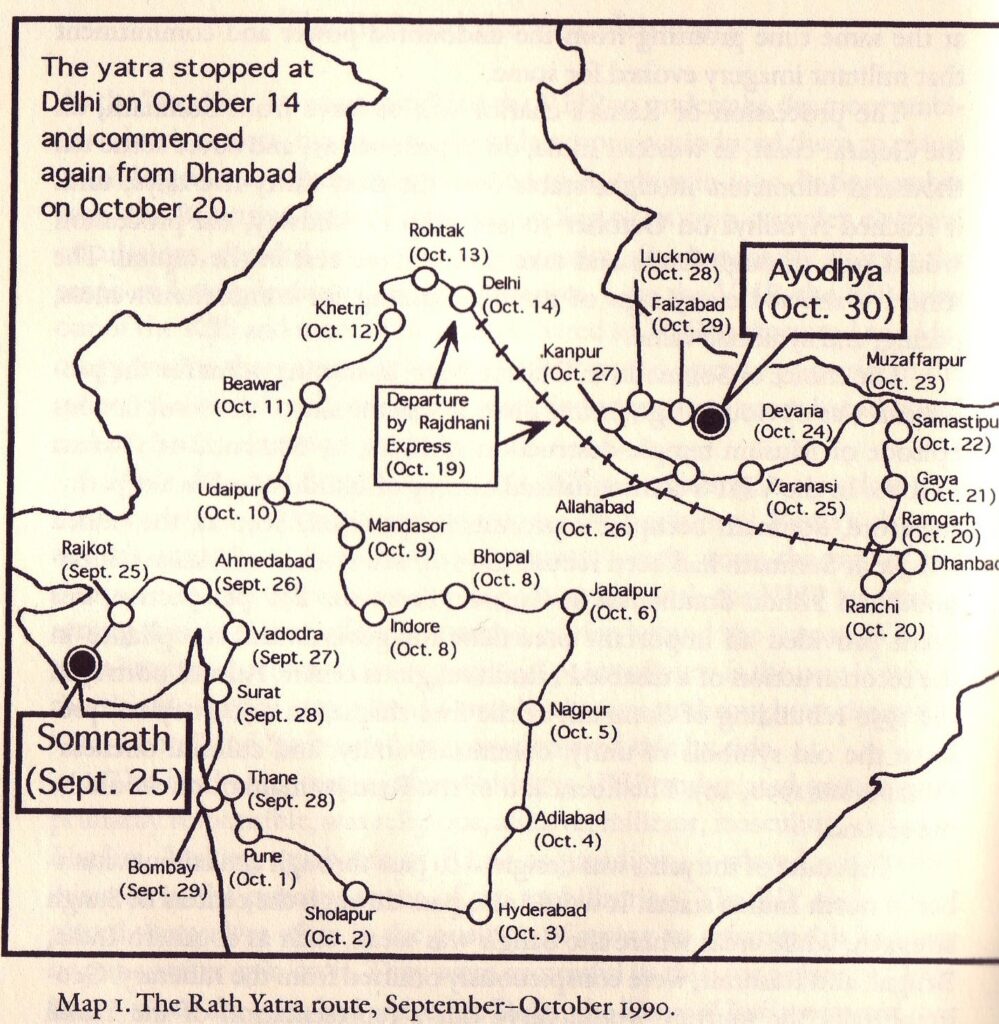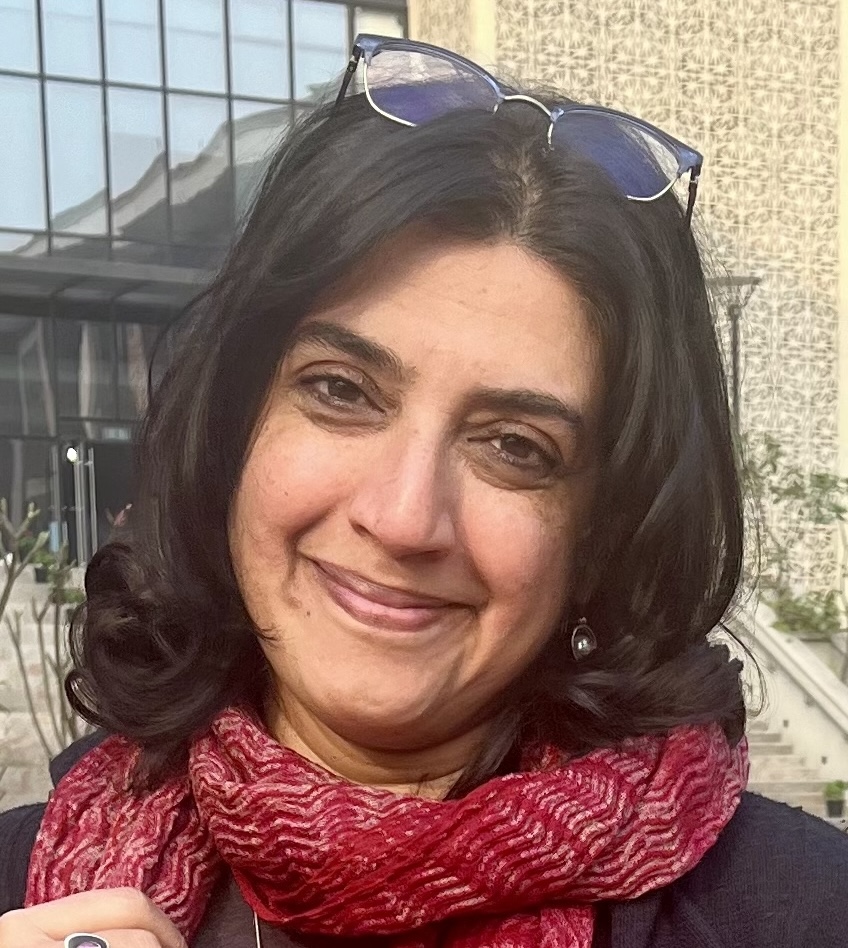
A New Incarnation
On January 22, 2024, India’s Prime Minister Narendra Modi performed a religious rite to consecrate the idol of the Hindu god Ram, in child form, at a huge temple in Ayodhya that is still under construction.
In Part 1 of this essay, I explained how the possibility of such an event taking place in democratic India in early 2024 had its roots in the rise of Hindu Nationalist ideology over the past 100 years, beginning in the 1920s. A breaking point came in August 1947, with a chaotic Partition and the tumultuous birth of secular India and Muslim Pakistan as independent but asymmetric nation-states. The conflict escalated further when, in January 1948, fanatical Hindu supremacists assassinated Mahatma Gandhi, the apostle of non-violence and leader of India’s long struggle for self-rule. Gandhi’s killers blamed him and the Indian National Congress under his influence for allowing the creation of a separate Muslim homeland at the price of a painful and blood-soaked territorial division of Britain’s colonial empire on the subcontinent.
The Hindu Right bore a fundamental grudge against the very existence of Pakistan because of which the two countries, though immediate neighbors and in many ways culturally indistinguishable from one another, have been to war several times in their post-colonial history. This unreconciled resentment continues to have serious repercussions even today, more than 75 years later, especially for Indian Muslims with a population of about 200 million people, the largest religious minority in the country.
The more proximate causes of the inauguration of the Ram Temple in August 2020 and the installation of the image of Ram as a 5-year-old child in January 2024—both rituals performed personally by the Indian Prime Minister—take us back to the demolition of the Babri Mosque in Ayodhya in December 1992, at the very site where the temple now stands, in a mob attack launched by Hindu militants. The physical destruction of the mosque a little over three decades ago triggered an escalating polarization of Hindus and Muslims, the exponential growth of right-wing Hindu politics, and the ratification of Hindu Nationalism by Indian voters, 80% of whom are Hindu, in the general elections of 2014 and 2019.
Built around the ideology known as Hindutva—which seeks to redefine India as a nation of and for Hindus, without accommodating other religious minorities, especially Muslims, as equal citizens—the Bharatiya Janata Party (BJP), founded in 1980, has been campaigning relentlessly to set to rest what it defines as the “unfinished business of Partition,” namely, the replacement of a diverse, plural, multi-religious India by a majoritarian Hindu Rashtra.
The physical destruction of the mosque a little over three decades ago triggered an escalating polarization of Hindus and Muslims—as also of secular Indians and Hindu Nationalists.
As India, the most populous democracy on the planet, goes to the polls yet again between mid-April and early June 2024—the world’s largest-ever election—how are we to understand the ways in which the ruling BJP, poised for a third consecutive win at the hustings, under the leadership of the authoritarian populist strongman Narendra Modi, is leveraging a set of religious symbols associated with the god Ram? These include his capital Ayodhya, his ideal kingdom Ram Rajya, and what Hindu Nationalists insist is the very location where Ram appeared on earth in human form, the avatar’s birthplace (janma-bhoomi).
By a hardline Hindu construal of the past, Babur, the Chagatai Turk who established the Mughal Empire in India in the late 1520s, destroyed a temple at the exact spot where Ram was born (janma-sthan), replacing it with a mosque named after himself, Babri Masjid. Ram’s devotees (bhakts) say they are reclaiming their deity’s birthplace 500 years after Babur usurped it. In addition to the well-known history of colonial and postcolonial India, is there also a medieval chapter that we need to revisit in order to fully grasp the political significance of Ayodhya?
Rewinding India’s History
It was no Hindu officiant but Prime Minister Modi who performed the rites meant to vitalize the idol of Ram Lalla (pran pratishtha—literally “the infusion of life”) on January 22, 2024. The government declared a half-day holiday, and the event completely dominated print, broadcast, and online media at the expense of other news. The country’s rich and famous, including billionaire industrialists, Bollywood stars, cricketers, and politicians were all in attendance. At the same time, Hindu holy men—i.e., sadhus and swamis, traditional pontiffs like the Shankaracharyas, and members of the opposition from political parties other than the BJP and its allies—were conspicuous by their absence.
Taking away the prerogative of performing the inaugural rituals from Hindu religious leaders, Modi arrogated these tasks to himself. But, as the elected leader of India’s secular democracy, qua prime minister his office ought not associate with any particular religious community. The cardinal separation of church and state as defined in the Indian Constitution of 1950 has been violated. “Hindutva” confuses the categories of politics and religion that India’s founders worked hard to keep apart. Despite Partition, through careful deliberations in the Constituent Assembly 1946–49, India’s first leaders set up an egalitarian state that did not premise the rights of citizens upon their religious identity.

In January 2024, the ruling rightwing BJP and a so-called “cultural” organization of volunteers affiliated with it, the Rashtriya Swayamsevak Sangh (RSS)—reminiscent of fascist cadres—mobilized Hindus all over the country, but especially in North India, by going door-to-door and asking people to display saffron flags bearing the slogan “Jai Shri Ram” (“Victory to Lord Ram”) on private homes and public buildings, neighborhood gates and local markets, streets and parks. They were successful, to the point that any vehicle, house, office, or shop not flying these bright orange banners stood out, dangerously signaling recalcitrance from what appeared to be a pervasive and comprehensive social consensus (or could be taken as that, based on the visual evidence).
State machinery, Hindu Right propaganda, and the entirety of the press, with almost no exception, carried the same messages: January 22, 2024, marked the start of a new age of history, “Amrit Kaal” (“Era of Bliss” or “Timeless Time,” a golden age invoking “Ram Rajya” of yore). India would henceforth be redefined as a “Hindu Rashtra” (Hindu Nation). Ram Lalla was not installed for the first time, but rather, the idol returned to its original rightful spot at the janma-bhoomi, the birthplace of Ram in Ayodhya, echoing Ram’s own victorious homecoming.
This narrative has been put in place by BJP from the time of the November 2019 Supreme Court verdict allowing for a temple to be constructed at the site of the Babri Masjid, and subsequently the inauguration of the temple construction in August 2020 by the Prime Minister.
The messaging both from the government and in the media seemed unequivocal in its implication that this putative “return” corrected an “atrocity” that had occurred 500 years ago, in the early 16th century. That was when the first Mughal Emperor Babur ordered the destruction of the original temple for Ram Lalla and the building of a mosque over it in his own name. What Babur had removed (in 1528), Modi has reinstated (in 2024). The message hammered home by the BJP’s propaganda machinery is that Ram—after his long saga of exile, war, victory, and restitution—has come back home to Ayodhya.
This is the very core of the meaning of January 22, 2024—taking back the janma-bhoomi from the Babri Masjid and rebuilding at that site a Ram Mandir; the triumph of good over evil reminiscent of Ram’s victory over Ravan; the overcoming of erstwhile Muslim power by contemporary Hindu faith; the long overdue righting of historical wrongs. All of this comes about through the efforts of the BJP-RSS, brought to a triumphant culmination by their present-day heroic protagonist, their warrior-king, Narendra Modi.
Divinization and Demonization
In an important essay published in 1993, “Rāmāyaṇa and Political Imagination in India,” Sheldon Pollock showed how the epic had been used for political purposes from medieval times through the colonial and modern periods of Indian history. This is because in its very structure and narrative it lends itself to be read “mythopolitically.” In the aftermath of the Babri Masjid demolition and the Bombay riots, Pollock pointed to the “ready availability to reactionary Indian politics of central cultural icons like the Rāmāyaṇa.” He noted that the story has always supplied “a repertory of imaginative instruments for articulating a range of political discourses” (262).

The story has two crucial elements which make it particularly useful to the BJP in mobilizing Indians “in the name of a Hindu theocratic politics and against the Muslim population.” These are what Pollock identifies as the “divinization” of political sovereignty and the concomitant “demonization” of a designated Other. Pollock states: “Not only are these two the defining thematics of Vālmīki’s epic, they are two of the most powerful conceptions of the socio-political imagination” (281).
The Rāmāyaṇa was thus deployed repeatedly by polities all across northern India from the 11th to the 14th centuries, as Central Asian Muslims on horseback like the Ghaznavids, Ghurids, and Khaljis penetrated into the subcontinent. Turkic invaders, called “Turushka” in Sanskrit, were identified with Ravan’s demon hordes, called “Rakshasa,” whom Ram had to defeat to win back his wife and kingdom. Pollock points out that the identification of Ram and Ravan, divine king and demonic tyrant, Self and Other, did not everywhere necessarily map onto the Hindu versus Muslim binary—Bengal in the east and Tamil country in the south do not exhibit this sort of dichotomy.
Nevertheless, the relevant point is that the Hindu Right today appears to be tapping into long-running cultural habits of demonizing and othering Muslims—a historical pathology that rather than being resolved and laid to rest at Independence, was instead inflamed and exacerbated by Partition. The BJP’s ideological narrative of Hindus being enslaved, colonized, and humiliated for centuries, first by Muslims and then by White people, draws its toxic waters from these deep wells of resentment.
Haunted by the Past
With this broader arc of history in place, let us turn to a short history of Ayodhya, stretching over four decades from the mid-1980s to the mid-2020s. This brings us to the present moment, as India goes to the polls from April to June 2024.
The first in a chain of events (see Timeline) leading up to January 22, 2024, was the wildly popular television series Ramayana, which was broadcast on the state channel Doordarshan every Sunday between January 1987 and July 1988. In September and October 1990, the then BJP chief L.K. Advani led a chariot procession (Rath Yatra), beginning in Gujarat at the Somnath Temple, and ending in Ayodhya, where the party demanded that a Ram Mandir be established.

On Dec 6, 1992, a mob of armed Hindutva volunteers under Advani’s leadership physically attacked and destroyed the Babri Masjid in Ayodhya. This led to widespread violence between Hindus and Muslims, the worst of it in the city of Bombay (Mumbai), leaving about 1000 people, overwhelmingly Muslim, dead. The Bombay Riots were for Bombay what 9/11 was for New York City—an eruption of such catastrophic violence that it changed the city forever.
The so-called Ayodhya Title Dispute was in the Allahabad High Court from July 1996 and the Supreme Court of India delivered its final judgment in November 2019. The apex court recognized the disputed site as the janma-bhoomi, directed that a temple be built there, and allotted another plot of land at some distance to rebuild a mosque (see the history of the dispute).
Modi laid the foundation stone of the new Ram Mandir in Ayodhya a few months later in August 2020, despite the fact that the COVID-19 pandemic had broken out in February 2020 and India had a complete nationwide lockdown from March 25 to May 31 of that year. As mentioned earlier, even at the inauguration of the temple, it was Modi who personally performed the rites with the help of priests; this role of the principal officiant was not played by one or more religious leaders representing any of the major Hindu sects around the country.
The top brass of the RSS was prominently present at both inaugural rituals, of the temple (August 2020) and the idol (January 2024), sitting close to the Prime Minister, seemingly approving of the proceedings. As the RSS approaches its centenary in 2025, it is no doubt a matter of profound satisfaction for its leaders to see their ideology of Hindutva, for so long anathema in mainstream Indian politics, replace the founding ideals of the Indian republic.
Past, Present, and Future
The breakdown of the secular compact put in place by the founders of the Indian Republic at independence in 1947 and the promulgation of the egalitarian Indian Constitution in 1950; the growing polarization of the majority Hindu and the minority Muslim communities; the illiberal and authoritarian cast of the ruling regime of the Hindu Right that has been in power for a decade (and looks set for a third consecutive electoral victory this year); the apparently unstoppable appeal of populist strongman Narendra Modi, his political party the BJP, and the RSS ideology of “Hindutva” that he espouses; and the growing normalization of the idea of India as an ethno-nationalist Hindu Rashtra, where Muslims and other minorities are second-class citizens: all of this describes the juncture at which we have arrived.
But there is a long multicultural past, a complex socio-political dynamic between diverse groups, and a deep history of many religions (Hinduism, Islam, Buddhism, Sikhism, Jainism…) to be reckoned with. Without an account of the prominent place of the rama-katha, the story of Ram ubiquitous in India and the broader Indic sphere; the role of the epic Ramayana in political imagination starting around the beginning of the second millennium of the Common Era; and the twin forces of secular nationalism and religious nationalism that lead up to the making of modern India, as emergent from the crucible of British colonialism, we cannot arrive at a full understanding of what happened in Ayodhya on January 22, 2024.
There is a long multicultural past, a complex socio-political dynamic between diverse groups, and a deep history of many religions (Hinduism, Islam, Buddhism, Sikhism, Jainism . . . ) to be reckoned with in India.
As India votes this summer, the question now is: Can we comprehend what these developments might mean for India’s future as the world’s largest democracy? As a recent pre-poll survey by Lokniti-CSDS showed, an overwhelming number of people polled seemed not to place much emphasis on religious identity as the basis of Indian citizenship or nationality. 79% of respondents came out in favor of religious tolerance and India continuing to be a multi-religious society. Similarly, the Ram Mandir does not figure as a significant electoral issue. However, the temple does seem to help the BJP consolidate Hindu identity in the public perception. And it does seem almost certain that the BJP will be voted back to power for a third term.
Surely we need to take cognizance of history—with its deeply recessed cultural processes, memories and traumas—to comprehend how heroic warriors, sacred sites, epic poems, gods, temples and scriptures continue to exert such a powerful influence on the political imagination of democratic India.
April 1980: Establishment of the Bharatiya Janata party (BJP)
1987–1988: Weekly TV series “Ramayana”, 78 episodes
Sep.-Oct. 1990: BJP Chief L.K. Advani leads Rath Yatra from Somnath in Gujarat to Ayodhya in UP
Dec. 06, 1992: Destruction of the Babri Masjid in Ayodhya
Dec. 1992–Jan. 1993: Bombay Riots
A few days in 1996 + March 1998–May 2004: BJP-led government, under Prime Minister A.B. Vajpayee
Feb. 2002: The Gujarat Riots, under Chief Minister Narendra Modi
May 2014; May 2019: Successive BJP-led national governments, under Prime Minister Narendra Modi
Nov. 2019: Ayodhya Judgement from the Supreme Court of India
Aug. 2020: Ram Mandir inauguration, ground-breaking ceremony by Prime Minister Narendra Modi during the Covid pandemic
Jan. 2024: Ram Lalla idol consecrated by Prime Minister Narendra Modi

